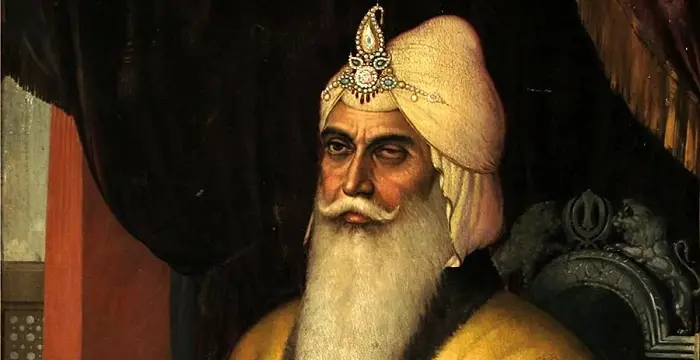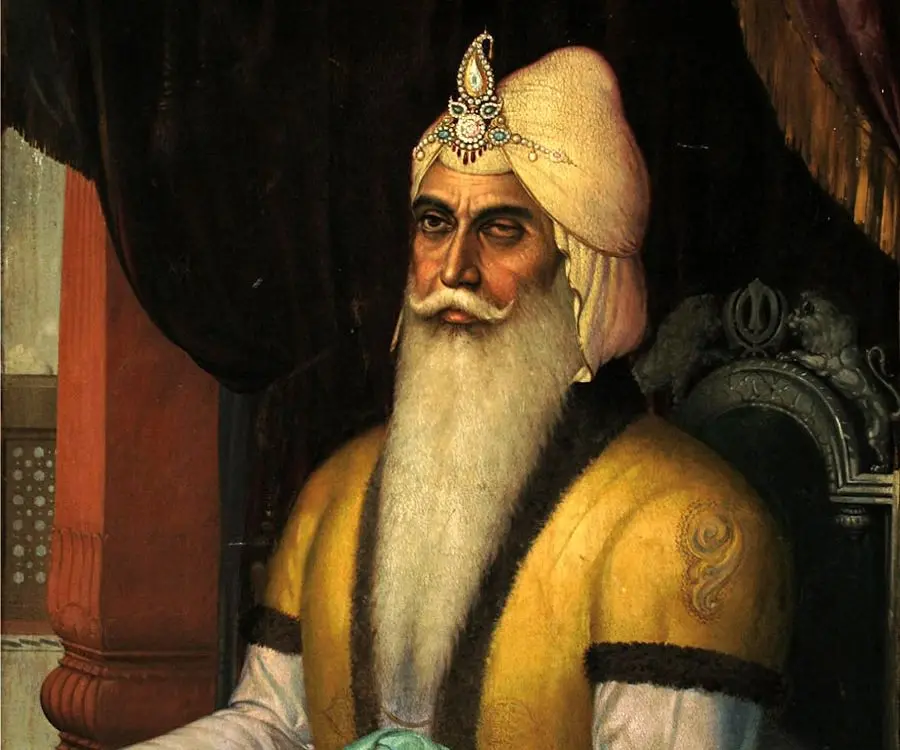
Maharaja Ranjit Singh - Kings, Birthday and Family
Maharaja Ranjit Singh's Personal Details
Maharaja Ranjit Singh was the founder of the Sikh Empire in the Punjab region
| Information | Detail |
|---|---|
| Birthday | November 13, 1780 |
| Died on | June 27, 1839 |
| Nationality | Indian |
| Famous | Historical Personalities, Emperors & Kings, Leaders, Emperors, Founder of the Sikh Empire, Kings |
| Spouses | Datar Kaur, Daya Kaur, Maharani Mahtab Devi Sahiba, Ratan Kaur |
| Childrens | Duleep Singh, Kharak Singh |
| Founder / Co-Founder |
|
| Birth Place | Gujranwala |
| Religion | Sikhism |
| Gender | Male |
| Father | Maha Singh |
| Mother | Raj Kaur |
| Sun Sign | Scorpio |
| Born in | Gujranwala |
| Famous as | Founder of the Sikh Empire |
| Died at Age | 58 |
// Famous Emperors
Sundiata Keita
Sundiata Keita was the founder of the Mali Empire in West Africa. This biography profiles his childhood, early life, struggles, founding of empire, rule, administration, achievements and also gives some fun facts.
Ashoka
Ashoka was the third emperor of the Mauryan Dynasty and ruled almost the entire Indian subcontinent. This biography profiles his childhood, life, reign, achievements and timeline
Murad IV
Murad IV was one of the mighty Sultans in the history of the Ottoman Empire. This biography profiles his childhood, family, accession, rule, administration and timeline.
Maharaja Ranjit Singh's photo
Who is Maharaja Ranjit Singh?
Maharaja Ranjit Singh was the founder of the Sikh Empire based in the Punjab region. He came to power in the early half of the 19th century, and his empire existed from 1799 to 1849. Born as the son of Maha Singh, the Commander of the Sukerchakia Misl—one of 12 Sikh Misls in Punjab during the 18th century—Ranjit Singh followed in his courageous father’s footsteps to become an even greater leader. He was born in a period when much of Punjab was ruled by the Sikhs under a Confederate Sarbat Khalsa system and the territory was divided among factions known as misls. His father died when Ranjit was 12 years old following which he was raised in the care of his mother Raj Kaur, and later his mother-in-law Sada Kaur. He took over as misldar of the Sukerchakia Misl upon attaining the age of 18 and set about expanding his territory. An ambitious man and a courageous warrior, he started conquering all the others misls and the annexation of Lahore from the Bhangi Misl marked the first important step in his rise to power. Eventually he conquered the region of central Punjab from the Sutlej to the Jhelum, vastly expanded his territory and founded the Sikh Empire. Because of his bravery and courage he earned the title of "Sher-e-Punjab" ("The Lion of Punjab").
// Famous Kings
Sundiata Keita
Sundiata Keita was the founder of the Mali Empire in West Africa. This biography profiles his childhood, early life, struggles, founding of empire, rule, administration, achievements and also gives some fun facts.
Ashoka
Ashoka was the third emperor of the Mauryan Dynasty and ruled almost the entire Indian subcontinent. This biography profiles his childhood, life, reign, achievements and timeline
Murad IV
Murad IV was one of the mighty Sultans in the history of the Ottoman Empire. This biography profiles his childhood, family, accession, rule, administration and timeline.
Childhood & Early Life
Ranjit Singh was born on 13 November, 1780, in Gujranwala, Sukerchakia Misl (present-day Pakistan) to Maha Singh and his wife Raj Kaur. His father was the Commander of the Sukerchakia Misl. As a child Ranjit Singh was afflicted with small pox which resulted in the loss of one eye.
Maha Singh died when Ranjit Singh was only 12 years old, leaving him to be raised by his mother.
He was married to Mehtab Kaur, the daughter of Sardar Gurbakash Singh Sandhu of the Kanhaiya Misl and Sada Kaur, in 1796, when he was 16 years old. Upon his marriage his mother-in-law also started taking active interest in his life.
Ascension & Reign
Ranjit Singh became the misldar of the Sukerchakia Misl at the age of 18. Upon assuming power he started campaigns to expand his territory.
He began his conquests by annexing the other misls and captured Lahore from the Bhangi Misl in 1799 and later made it his capital. He then captured the rest of the Punjab.
In 1801 he united all the Sikh factions into one state and assumed the title of “Maharaja” on 12 April—the day of Baisakhi. He was 20 years old at the time. Then he set forth further expanding his territory.
He conquered the holy city of Amritsar from the Bhangi Misl ruler Mai Sukhan in 1802. He continued his conquests by capturing Kasur from the Afghan chief Qutb ud-Din in 1807.
He went to the aid of Raja Sansar Chand of Kangra in the Lesser Himalayas in 1809 against an advancing Ghurka force. After defeating the forces, he added Kangra to his empire.
In 1813, he joined a Bārakzay Afghan expedition into Kashmir but was betrayed by the Bārakzays. Nonetheless he went on to rescue Shah Shoja, the brother of the deposed Afghan king, and occupied the fort at Attock on the Indus River, southeast of Peshawar. Then he pressurized Shah Shoja to part with the famous Koh-i-noor diamond that was in his possession.
He spent several years fighting the Afghans and driving them out of the Punjab. Eventually he captured Pashtun territory including Peshawar, and in 1818, the province of Multan. He put an end to more than a hundred years of Muslim rule in Multan Area with these conquests. He also annexed Kashmir in 1819.
Ranjit Singh was a secular ruler who had tremendous respect for all religions. His armies included Sikhs, Muslims, and Hindus and his commanders also hailed from different religious communities. In 1820 he began to modernize his army using several European officers to train the infantry and the artillery. The modernized army performed very well in the conquests in the North-West Frontier.
By the 1830s the British were beginning to expand their territories in India. They were intent on keeping the Sindh province for themselves and tried to make Ranjit Singh accept their plans. This was not acceptable to Ranjit Singh and he authorized an expedition led by Dogra commander Zorawar Singh that eventually extended Ranjit Singh’s northern territories into Ladakh in 1834.
In 1837, the last confrontation between the Sikhs and the Afghans took place in the Battle of Jamrud. The Sikhs were building up towards crossing the Khyber Pass and the Afghan forces confronted them at Jamrud. The Afghans attempted to retake Peshawar from the invading Sikhs but were unsuccessful.
Ranjit Singh was also much feared by the British and they did not dare to try to annex his territories for as long as he was alive. He died in 1839 and the Sikh army was defeated in the First Anglo-Sikh War in 1846. By the end of the Second Anglo-Sikh War in 1849, the Punjab was annexed by the British bringing an end to the glorious Sikh Empire.
Major Works
Maharaja Ranjit Singh founded the Sikh Empire, based around Punjab in 1799. It was a major power in the Indian subcontinent and at its peak, the Empire encompassed regions from the Khyber Pass in the west to western Tibet in the east, and from Mithankot in the south to Kashmir in the north.
Personal Life & Legacy
Ranjit Singh was married multiple times and had Sikh, Hindu, as well as Muslim wives. Some of his wives were Mehtab Kaur, Rani Raj Kaur, Rani Rattan Kaur, Rani Chand Kaur, and Rani Raj Banso Devi.
He also had several children including sons Kharak Singh, Ishar Singh, Sher Singh, Pashaura Singh and Duleep Singh. However he acknowledged only Kharak Singh and Duleep Singh as his biological sons.
He died on 27 June 1839 in Lahore, Punjab, Sikh Empire. He was cremated and his remains are stored in the Samadhi of Ranjit Singh in Lahore, Punjab. He was succeeded by his son Kharak Singh.
He is remembered for being an able and just ruler with a magnificent personality. His empire was secular where all religions were respected and no one was discriminated against because of their religious beliefs. He also played a major role in the golden beautification of the Harmandir Sahib. He was much respected throughout the world for his courage and valor and was known as "Sher-e-Punjab" ("The Lion of Punjab").
Maharaja Ranjit Singh biography timelines
- // 13th Nov 1780Ranjit Singh was born on 13 November, 1780, in Gujranwala, Sukerchakia Misl (present-day Pakistan) to Maha Singh and his wife Raj Kaur. His father was the Commander of the Sukerchakia Misl. As a child Ranjit Singh was afflicted with small pox which resulted in the loss of one eye.
- // 1796He was married to Mehtab Kaur, the daughter of Sardar Gurbakash Singh Sandhu of the Kanhaiya Misl and Sada Kaur, in 1796, when he was 16 years old. Upon his marriage his mother-in-law also started taking active interest in his life.
- // 1799He began his conquests by annexing the other misls and captured Lahore from the Bhangi Misl in 1799 and later made it his capital. He then captured the rest of the Punjab.
- // 1799Maharaja Ranjit Singh founded the Sikh Empire, based around Punjab in 1799. It was a major power in the Indian subcontinent and at its peak, the Empire encompassed regions from the Khyber Pass in the west to western Tibet in the east, and from Mithankot in the south to Kashmir in the north.
- // 1801In 1801 he united all the Sikh factions into one state and assumed the title of “Maharaja” on 12 April—the day of Baisakhi. He was 20 years old at the time. Then he set forth further expanding his territory.
- // 1802 To 1807He conquered the holy city of Amritsar from the Bhangi Misl ruler Mai Sukhan in 1802. He continued his conquests by capturing Kasur from the Afghan chief Qutb ud-Din in 1807.
- // 1809He went to the aid of Raja Sansar Chand of Kangra in the Lesser Himalayas in 1809 against an advancing Ghurka force. After defeating the forces, he added Kangra to his empire.
- // 1813In 1813, he joined a Bārakzay Afghan expedition into Kashmir but was betrayed by the Bārakzays. Nonetheless he went on to rescue Shah Shoja, the brother of the deposed Afghan king, and occupied the fort at Attock on the Indus River, southeast of Peshawar. Then he pressurized Shah Shoja to part with the famous Koh-i-noor diamond that was in his possession.
- // 1818 To 1819He spent several years fighting the Afghans and driving them out of the Punjab. Eventually he captured Pashtun territory including Peshawar, and in 1818, the province of Multan. He put an end to more than a hundred years of Muslim rule in Multan Area with these conquests. He also annexed Kashmir in 1819.
- // 1820Ranjit Singh was a secular ruler who had tremendous respect for all religions. His armies included Sikhs, Muslims, and Hindus and his commanders also hailed from different religious communities. In 1820 he began to modernize his army using several European officers to train the infantry and the artillery. The modernized army performed very well in the conquests in the North-West Frontier.
- // 1834By the 1830s the British were beginning to expand their territories in India. They were intent on keeping the Sindh province for themselves and tried to make Ranjit Singh accept their plans. This was not acceptable to Ranjit Singh and he authorized an expedition led by Dogra commander Zorawar Singh that eventually extended Ranjit Singh’s northern territories into Ladakh in 1834.
- // 1837In 1837, the last confrontation between the Sikhs and the Afghans took place in the Battle of Jamrud. The Sikhs were building up towards crossing the Khyber Pass and the Afghan forces confronted them at Jamrud. The Afghans attempted to retake Peshawar from the invading Sikhs but were unsuccessful.
- // 1839 To 1849Ranjit Singh was also much feared by the British and they did not dare to try to annex his territories for as long as he was alive. He died in 1839 and the Sikh army was defeated in the First Anglo-Sikh War in 1846. By the end of the Second Anglo-Sikh War in 1849, the Punjab was annexed by the British bringing an end to the glorious Sikh Empire.
- // 27th Jun 1839He died on 27 June 1839 in Lahore, Punjab, Sikh Empire. He was cremated and his remains are stored in the Samadhi of Ranjit Singh in Lahore, Punjab. He was succeeded by his son Kharak Singh.
// Famous Emperors & Kings
Sundiata Keita
Sundiata Keita was the founder of the Mali Empire in West Africa. This biography profiles his childhood, early life, struggles, founding of empire, rule, administration, achievements and also gives some fun facts.
Ashoka
Ashoka was the third emperor of the Mauryan Dynasty and ruled almost the entire Indian subcontinent. This biography profiles his childhood, life, reign, achievements and timeline
Murad IV
Murad IV was one of the mighty Sultans in the history of the Ottoman Empire. This biography profiles his childhood, family, accession, rule, administration and timeline.
Xerxes I
Xerxes I (Xerxes the Great) was the fourth and the most famous king of the Archaemenid dynasty of Persia. This biography profiles his childhood, family, personal life, life history, achievements, campaigns, administration, death and other facts.
Sargon of Akkad
Sargon of Akkad, also called ‘Sargon the Great’, ‘Sarru-Kan’ and ‘Shar-Gani-Sharri’, was the founder and first king of the Akkadian Empire. This biography profiles his childhood, life, rule, administration, timeline, and gives some fun facts.
Abdullah of Saudi Arabia
Abdullah bin Abdulaziz Al Saud was the King of Saudi Arabia from 2005 to 2015 and the third wealthiest head of state in the world. Find more facts about his life, childhood and timeline.
Maharaja Ranjit Singh's FAQ
What is Maharaja Ranjit Singh birthday?
Maharaja Ranjit Singh was born at 1780-11-13
When was Maharaja Ranjit Singh died?
Maharaja Ranjit Singh was died at 1839-06-27
Where was Maharaja Ranjit Singh died?
Maharaja Ranjit Singh was died in Lahore
Which age was Maharaja Ranjit Singh died?
Maharaja Ranjit Singh was died at age 58
Where is Maharaja Ranjit Singh's birth place?
Maharaja Ranjit Singh was born in Gujranwala
What is Maharaja Ranjit Singh nationalities?
Maharaja Ranjit Singh's nationalities is Indian
Who is Maharaja Ranjit Singh spouses?
Maharaja Ranjit Singh's spouses is Datar Kaur, Daya Kaur, Maharani Mahtab Devi Sahiba, Ratan Kaur
Who is Maharaja Ranjit Singh childrens?
Maharaja Ranjit Singh's childrens is Duleep Singh, Kharak Singh
Which company or organization was founded by Maharaja Ranjit Singh?
Maharaja Ranjit Singh was the founder/co-founder of Sikh Empire
What is Maharaja Ranjit Singh's religion?
Maharaja Ranjit Singh's religion is Sikhism
Who is Maharaja Ranjit Singh's father?
Maharaja Ranjit Singh's father is Maha Singh
Who is Maharaja Ranjit Singh's mother?
Maharaja Ranjit Singh's mother is Raj Kaur
What is Maharaja Ranjit Singh's sun sign?
Maharaja Ranjit Singh is Scorpio
How famous is Maharaja Ranjit Singh?
Maharaja Ranjit Singh is famouse as Founder of the Sikh Empire







